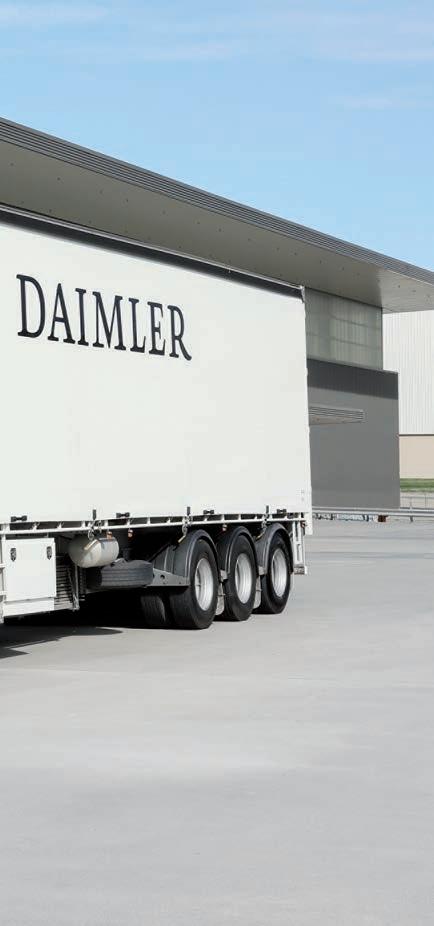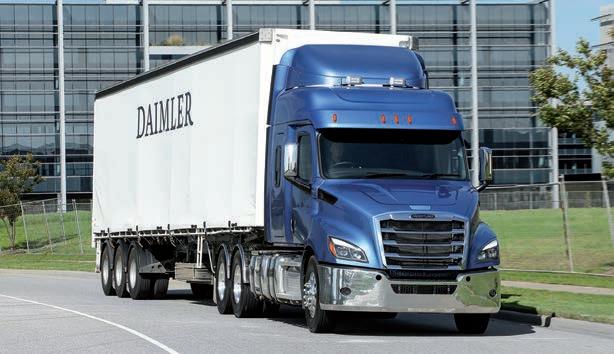
8 minute read
Beast Mode
Anyone who gets close to the Freightliner Cascadia can’t help but be impressed, unless, of course, you’re the competition.
The Freightliner Cascadia was launched in the US in 2007 and was the focus of a major update in 2016. In excess of 200,000 Cascadia’s have been built to date and the Cleveland plant in Charlotte, North Carolina currently produces America’s most popular heavy duty truck at the rate of 106 per day. The Cascadia holds an enviable 40 per cent share of the US Class 8 market which is the equivalent to our own Heavy Duty sector and after comprehensive engineering attention and exhaustive testing regimes, America’s most advanced conventional cab truck is at last available in Australia and New Zealand. Australian road transport is unique for its heavy gross weights, relatively high average speeds and our climate’s high ambient temperatures. Some manufacturers in the past have found to their own detriment that something which may work satisfactorily in North America or Europe can be left struggling here. Freightliner may have North America’s most successful truck in the Cascadia but there has never been any indication of it being foisted onto the Australian market without exhaustive assessments to ensure it was absolutely fit for purpose and suitable for Australian applications. Backing Freightliner’s admirable intentions has been an astonishing $100m investment in developing the right hand drive models destined for Australia and New Zealand. It’s obvious the money has been well spent and, all things being equal, should ultimately return Daimler Trucks a healthy dividend. However, the money hasn’t been just directed at engineering or simply creating a mirror-image dashboard to suit the relocated steering gear. A sizeable chunk has also been spent on testing and evaluation and subsequently addressing any areas found to be wanting. Customers can no longer be used as test beds or canaries in a mine, and the North

American Cascadia models had already undergone millions of miles in testing prior to the genesis of the Australian version. In recognition of our tougher requirements the RHD trucks have been pounded even harder in testing than the US models just in case any potential shortcomings were missed. “There is no such thing as a world truck,” says Martin Daum, Chairman of the Board of Management, Daimler Truck AG at the local launch of the Cascadia. “We listened to our customers in Australia and New Zealand and developed this truck specifically for them.” Crucially, any lessons learned from the more arduous testing regime were incorporated into the Australian production models. “We made some changes and are extremely confident this truck is ready to start saving money for our customers and delivering an on-road experience we know drivers will love,” says Stephen Downes, Freightliner Australia Pacific Director. Downes, along with local Daimler Trucks CEO Daniel Whitehead, throughout the process of developing the Cascadia for Australia has been consistently confident in the Cascadia’s abilities. Prime Mover has met with one US operator who bought their first Freightliner prime mover in 1985 and has purchased more than 22,000 examples of the brand since and has more than 4,500 Cascadia’s in its current fleet. Based in Salt Lake City, CR England operates on a sufficient scale to regularly purchase from the ‘other’ brands in order to assess comparison metrics and to validate their own commitment to the Freightliner marque. Full size wind tunnel testing has fostered development of an efficient overall aero package plus some little aerodynamic enhancements, similar to those found on NASCAR vehicles, which collectively contribute to the Cascadia’s ability to cheat the wind and consequently save fuel. The symmetrical design of the alloy cab makes for a more robust cab regardless of which side the driver sits and the structure meets the ECE R29 cab strength criteria. With steel doors, the separate firewall contributes to a better

manufacturing process. Solid design elements in the manufacturing has, to our ear, resulted in a cab free from squeaks or rattles. The DT12 automated transmission accounts for more than 80 per cent of Cascadia truck orders in North America, offering an enhanced integration with the Detroit Diesel engines and providing a significant contribution to the Cascadia’s fuel economy while making the driver’s task much easier. The transmission’s eCoast feature saves fuel by disengaging the driveline when cruise control is activated and there is no input from the driver via the accelerator pedal. As a safety precaution the eCoast will not engage on slopes greater than 3.5 per cent and has an automatic Hill Start Aid function which holds the truck for three seconds to avoid rollback. The DT12’s Cruise Descent Control helps control the truck’s speed when descending a grade and there’s a ‘creep mode’ to assist in manoeuvring and trailer connecting. The Intelligent Powertrain Management system uses topographical mapping to maximise coasting opportunities and avoid situations such as unnecessary downshifts just as the truck is cresting a hill. For Australian operators who still prefer a manual transmission the Eaton 18-speed is available but not in the UltraShift AMT version. In terms of electronic driver aids the Cascadia is more a connected
AUSTRALIAN ENGINE RATINGS DD13 RATINGS 450hp at 1625rpm and 1650lb.ft at 975rpm 470hp at 1625rpm and 1650lb.ft at 975rpm 505hp at 1625rpm and 1850lb.ft at 975rpm DD16 ratings 500hp at 1800rpm and 1850lb.ft at 1120rpm 530hp at 1800rpm and 1850lb.ft at 1120rpm 560hp at 1800rpm and 1850lb.ft at 1120rpm 560hp at 1800rpm and 2050lb.ft at 1120rpm 600hp at 1800rpm and 1850lb.ft at 1120rpm 600hp at 1800rpm and 2050lb.ft at 1120rpm

technological platform than a simple truck. The Cascadia can match the best of European commercial vehicles with its multitude of sophisticated, yet intuitive to use, electronics-based systems which assist the driver in the overall operation of the truck, the safety of the occupants and other road users, and also for comfort and entertainment. For Australia, Freightliner has taken the decision to make a host of advanced safety features standard equipment including the fully-integrated Detroit Assurance 5.0 which uses a radar and a high definition camera for Active Emergency Braking and to facilitate the Active Cruise Control. Tailgate warning, lane departure warning, intelligent (self-dipping) high beam and automatic wipers and headlamps are all standard equipment, as are the expected antiskid disc brakes, traction control and Electronic Stability Control. The Cascadia is the first truck in Australia to be equipped with Detroit Connect which provides an impressive level of telematic connectivity which enables vehicle updates to be performed remotely as well as fault code diagnosis and even repair recommendations. The Sideguard Assist system uses two short-range radars (one aiming forward and one aiming back) on the kerbside to warn the driver of potential collisions between the trailer and objects such as power poles when turning left (Trailer Sweep Assist) and also warns the driver if they are about to merge left into an already occupied lane (Turn Assist). At the front, the forwardfacing radar and camera system has the capability to detect a pedestrian and quickly bring the truck to a complete stop with no input from the driver. Meanwhile, the Intelligent Powertrain Management uses GPS and ‘road reading’ to minimise fuel use without compromising point-to-point travel times. This extensive use of electronics doesn’t intimidate the driver by any means and contributes to a genuine sense of confidence that the truck is being driven efficiently and safely with a human being in control. The power choices are the first Detroit DD16 sixteen litre engine to be offered in Australia as well as the thirteen litre DD13 engine. These new-generation engines differ substantially from the existing DD13 and DD15 units and surpass Euro 6 emission standards by meeting the stricter US GHG17 standards using an enhanced SCR system, a small degree of EGR and a diesel particulate filter, which historically in the USA, requires no manual regeneration ‘burns’. There is significant torque delivery from the DD13 at low rpms, thanks to its asymmetric turbo, which is built in-house at the Detroit factory. The DD16’s flat torque curve is in part thanks to the turbo compounding feature already seen here on the DD15 which scavenges energy that would otherwise be lost down the exhaust system and feeds it back into the engine via a gear train. Initially the Cascadia is available locally in either 116 or 126 inch BBC (bumper to back of cab) dimensions with the choice of a day cab or several sleepers with the 36 inch sleeper ideally applicable to 26 metre B-double applications, plus 48 inch and low 60 inch options and a high-roof 60 incher. The inner spring mattresses in the sleepers are quality Sealy Posturepedic items and there is a twin bunk option. Freightliner has worked with Teague, the interior design firm responsible for much of the interior of the Boeing 787 Dreamliner, to deliver work and sleep spaces of aircraft quality with on-point ergonomics. The stylish wrap around dashboard has a car type instrument cluster directly in front of the driver and there are cup-holders and in-dash storage, in-door pockets and two overhead cabinets in the day cab, with more storage options in the sleepers. Seat trims include standard Laredo leather, and customers can also opt for a range of vinyl or cloth materials as well as Isri seats. The local Cascadia features a lightweight aluminium bumper designed by Freightliner and manufactured in Australia which meets current FUPD requirements. Freightliner has also worked with local bullbar manufacturers in the development of additional protection without compromising safety or aerodynamics. Freightliner claims this is the most advanced conventional truck in Australia and that’s hard to dispute across a number of factors including fuel efficiency, driver comfort, connectivity and what is undoubtedly the most advanced safety technology ever available in Australia in a conventional cabin truck.
D O Y O U K N O W A N O U T S TA N D I N G F E M A L E LEADER IN YOUR INDUSTRY?
NOW OPEN NOMINATIONS

WOMEN I N INDUSTRY .COM.AU
PROUDLY PRESENTED BY










